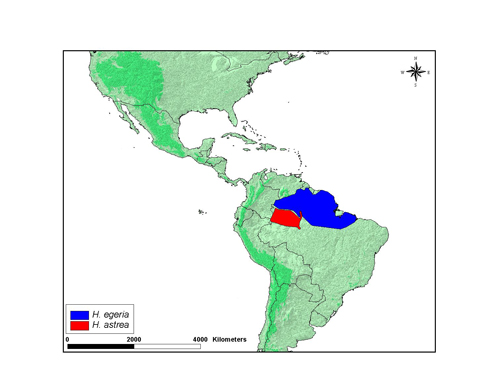Heliconius astraea
Andrew V. Z. Brower and Margarita BeltránIntroduction
An Amazonian Heliconius species belonging to the H. egeria group and exhibiting the common red-and-yellow "dennis/ray" mimetic wing pattern.
Etymology: Astraea is the star-maiden, daughter of Zeus and Themis. She was, as was her mother, a goddess of justice. During the Golden Age, when the gods dwelled among mankind, she lived on the earth. When evil and wickedness increased its grip on humanity, the gods abandoned the habitations of mankind. Astraea was the last to leave and took up her abode among the stars where she was transformed into the constellation Virgo (Astraea).
Characteristics
Early stages: Eggs are cream and approximately 1.2 x 0.9 mm (h x w). Females usually place 1 to 3 eggs on growing shoots of the host plant. Mature larvae have an orange body with black spots, with black scoli and head, length is around 2 cm. Caterpillars are gregarious. (Brown, 1981).
Habits
H. astraea occurs from sea level to 1,300 m in the forest canopy. Usually individuals fly rapidly and in the canopy. Females mate multiply and adults roost solitarily at night 2-10 m above the ground on twigs or tendrils.
Host plant: H. astraea larvae feed primarily on plants from the genus Passiflora, subgenus Distephana (Brown, 1981).
Geographical distribution
Heliconius astraea is distributed from Brazil to Peru. This map shows an approximate representation of the geographic distribution of this species. The original data used to draw these maps are derived from Brown (1979) which is available at Keith S. Brown Jr. (1979). Ecological Geography and Evolution in Neotropical Forests
Geographical Races
Two minor geographical races have been described:
- Heliconius astraea astraea Staudinger 1897, northern Amazonia
- Helicoius astraea rondonia K. S. Brown 1973, Rio Madeira, Brazil
References
"Astraea." Encyclopedia Mythica from Encyclopedia Mythica Online. http://www.pantheon.org/articles/a/astraea.html [Accessed May 22, 2008].
Brown K. S. 1981 The Biology of Heliconius and Related Genera. Annual Review of Entomology 26, 427-456.
Brown, K. S., Jr. 1973 The heliconians of Brazil (Lepidoptera: Nymphalidae). Part V. Three new subspecies from Mato Grosso and Rondônia. Bull. Allyn Mus. 13, 1-19.
Staudinger, O. 1897 Neue Heliconius-Arten und Formen. Deutsches Ent. Zeit. Iris 9, 284-317, 2 plates.
About This Page
Andrew V. Z. Brower

Middle Tennessee State University, Murfreesboro, Tennessee, USA
Margarita Beltrán

University of Cambridge, Cambridge, UK
Correspondence regarding this page should be directed to Andrew V. Z. Brower at
abrower@mtsu.edu
and Margarita Beltrán at
beltran.margarita@gmail.com
Page copyright © 2010 Andrew V. Z. Brower and Margarita Beltrán
 Page: Tree of Life
Heliconius astraea .
Authored by
Andrew V. Z. Brower and Margarita Beltrán.
The TEXT of this page is licensed under the
Creative Commons Attribution License - Version 3.0. Note that images and other media
featured on this page are each governed by their own license, and they may or may not be available
for reuse. Click on an image or a media link to access the media data window, which provides the
relevant licensing information. For the general terms and conditions of ToL material reuse and
redistribution, please see the Tree of Life Copyright
Policies.
Page: Tree of Life
Heliconius astraea .
Authored by
Andrew V. Z. Brower and Margarita Beltrán.
The TEXT of this page is licensed under the
Creative Commons Attribution License - Version 3.0. Note that images and other media
featured on this page are each governed by their own license, and they may or may not be available
for reuse. Click on an image or a media link to access the media data window, which provides the
relevant licensing information. For the general terms and conditions of ToL material reuse and
redistribution, please see the Tree of Life Copyright
Policies.
- First online 24 June 2008
- Content changed 13 August 2008
Citing this page:
Brower, Andrew V. Z. and Margarita Beltrán. 2008. Heliconius astraea . Version 13 August 2008 (under construction). http://tolweb.org/Heliconius_astraea/72912/2008.08.13 in The Tree of Life Web Project, http://tolweb.org/








 Go to quick links
Go to quick search
Go to navigation for this section of the ToL site
Go to detailed links for the ToL site
Go to quick links
Go to quick search
Go to navigation for this section of the ToL site
Go to detailed links for the ToL site